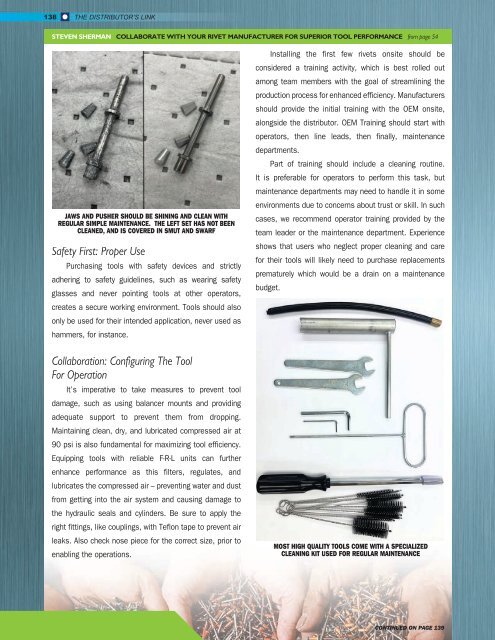FALL 2023
Distributor's Link Magazine Fall 2023 / Vol 46 No 4
Distributor's Link Magazine Fall 2023 / Vol 46 No 4
Create successful ePaper yourself
Turn your PDF publications into a flip-book with our unique Google optimized e-Paper software.
138<br />
THE DISTRIBUTOR’S LINK<br />
STEVEN SHERMAN COLLABORATE WITH YOUR RIVET MANUFACTURER FOR SUPERIOR TOOL PERFORMANCE from page 54<br />
JAWS AND PUSHER SHOULD BE SHINING AND CLEAN WITH<br />
REGULAR SIMPLE MAINTENANCE. THE LEFT SET HAS NOT BEEN<br />
CLEANED, AND IS COVERED IN SMUT AND SWARF<br />
Safety First: Proper Use<br />
Purchasing tools with safety devices and strictly<br />
adhering to safety guidelines, such as wearing safety<br />
glasses and never pointing tools at other operators,<br />
creates a secure working environment. Tools should also<br />
only be used for their intended application, never used as<br />
hammers, for instance.<br />
Collaboration: Configuring The Tool<br />
For Operation<br />
It’s imperative to take measures to prevent tool<br />
damage, such as using balancer mounts and providing<br />
adequate support to prevent them from dropping.<br />
Maintaining clean, dry, and lubricated compressed air at<br />
90 psi is also fundamental for maximizing tool efficiency.<br />
Equipping tools with reliable F-R-L units can further<br />
enhance performance as this filters, regulates, and<br />
lubricates the compressed air – preventing water and dust<br />
from getting into the air system and causing damage to<br />
the hydraulic seals and cylinders. Be sure to apply the<br />
right fittings, like couplings, with Teflon tape to prevent air<br />
leaks. Also check nose piece for the correct size, prior to<br />
enabling the operations.<br />
Installing the first few rivets onsite should be<br />
considered a training activity, which is best rolled out<br />
among team members with the goal of streamlining the<br />
production process for enhanced efficiency. Manufacturers<br />
should provide the initial training with the OEM onsite,<br />
alongside the distributor. OEM Training should start with<br />
operators, then line leads, then finally, maintenance<br />
departments.<br />
Part of training should include a cleaning routine.<br />
It is preferable for operators to perform this task, but<br />
maintenance departments may need to handle it in some<br />
environments due to concerns about trust or skill. In such<br />
cases, we recommend operator training provided by the<br />
team leader or the maintenance department. Experience<br />
shows that users who neglect proper cleaning and care<br />
for their tools will likely need to purchase replacements<br />
prematurely which would be a drain on a maintenance<br />
budget.<br />
MOST HIGH QUALITY TOOLS COME WITH A SPECIALIZED<br />
CLEANING KIT USED FOR REGULAR MAINTENANCE<br />
CONTINUED ON PAGE 139
















